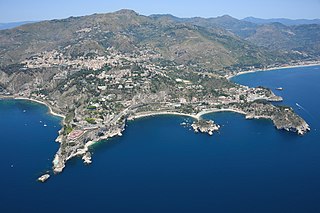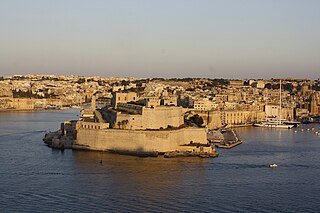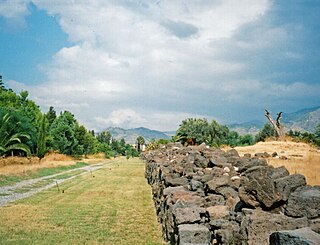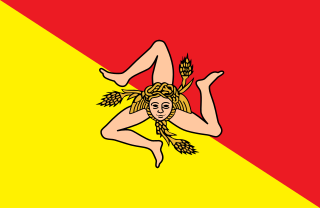
Sicily is the largest and most populous island in the Mediterranean Sea and one of the 20 regions of Italy. The Strait of Messina divides it from the region of Calabria in Southern Italy. It is one of the five Italian autonomous regions and is officially referred to as Regione Siciliana. The region has 5 million inhabitants. Its capital city is Palermo.

Tindari, ancient Tyndaris or Tyndarion, is a small town, frazione in the comune of Patti and a Latin Catholic titular see.

Messina is a harbour city and the capital of the Italian Metropolitan City of Messina. It is the third largest city on the island of Sicily, and the 13th largest city in Italy, with a population of more than 219,000 inhabitants in the city proper and about 650,000 in the Metropolitan City. It is located near the northeast corner of Sicily, at the Strait of Messina and it is an important access terminal to Calabria region, Villa San Giovanni, Reggio Calabria on the mainland. According to Eurostat the FUA of the metropolitan area of Messina has, in 2014, 277,584 inhabitants.

Taormina is a comune (municipality) in the Metropolitan City of Messina, on the east coast of the island of Sicily, Italy. Taormina has been a tourist destination since the 19th century. Its beaches on the Ionian sea, including that of Isola Bella, are accessible via an aerial tramway built in 1992, and via highways from Messina in the north and Catania in the south. On 26–27 May 2017 Taormina hosted the 43rd G7 summit.

The Strait of Messina Bridge was a proposal to build a suspension bridge across the Strait of Messina in Italy to connect the cities of Torre Faro and Villa San Giovanni.

The Battle of Malta took place on 8 July 1283 in the entrance to the Grand Harbour, the principal harbour of Malta, as part of the War of the Sicilian Vespers. An Aragonese fleet of galleys, commanded by Roger of Lauria, attacked and defeated a fleet of Angevin galleys commanded by Guillaume Cornut and Bartholomé Bonvin.

Halaesa, also known as Halaesa Archonidea and also spelled Alaesa or Halesa was an ancient city of Sicily, situated near the north coast of the island, between Cephaloedium and Calacte.

Naxos or Naxus was an ancient Greek city, presently situated in modern Giardini Naxos near Taormina on the east coast of Sicily.

The flag of Sicily shows a triskeles symbol, and at its center a Gorgoneion and a pair of wings and three wheat ears.

The Salso, also known as the Imera Meridionale, is a river of Sicily. It rises in the Madonie Mountains and, traversing the provinces of Enna and Caltanissetta, flows into the Mediterranean at the western end of the Gulf of Gela at the seaport of Licata, in the Province of Agrigento. Its small deltaic system there is dominated by marine processes rather than fluvial ones. It is a seasonal torrent, with brief but violent floods during the winter rains, and all but dry in summer droughts. In November 1915 the iron bridge across the river's mouth collapsed during floods, and 119 people were swept away in the flood and lost. The Salso, which is the longest river of Sicily at 132 kilometres (82 mi), has a drainage basin area of 2,022 square kilometres (781 sq mi).
Scyllaeum was a promontory, and ancient town or fortress, on the west coast of Bruttium, about 25 km north of Rhegium, and almost exactly at the entrance of the Sicilian strait.

Eryx was an ancient city and a mountain in the west of Sicily, about 10 km from Drepana, and 3 km from the sea-coast. It was located at the site of modern Erice.

Naulochus, Naulochos, Naulochoi, or Naulocha, was an ancient city on the north coast of Sicily, between Mylae and Cape Pelorus. It is known primarily from the great sea-fight in which Sextus Pompeius was defeated by Marcus Vipsanius Agrippa, 36 BCE, and which was fought between Mylae and Naulochus. Pompeius himself during the battle had been encamped with his land forces at Naulochus, and after his victory, Octavian, in his turn, took up his station there, while Agrippa and Lepidus advanced to attack Messana. It is clear from its name that Naulochus was a place where there was a good roadstead or anchorage for shipping. Some have doubted its existence as a populated place, but Silius Italicus includes it in his list of Sicilian cities. From the description in Appian it is clear that it was situated between Mylae and Cape Rasoculmo, and probably not very far from the latter point; but there is nothing to fix its site more definitely. The editors of the Barrington Atlas of the Greek and Roman World place it near the modern comune of Spadafora.

Capo Passero or Cape Passaro is a celebrated promontory of Sicily, forming the extreme southeastern point of the whole island, and one of the three promontories which were supposed to have given to it the name of "Trinacria."
The Battle of Messene took place in 397 BC in Sicily. Carthage, in retaliation for the attack on Motya by Dionysius, had sent an army under Himilco, to Sicily to regain lost territory. Himilco sailed to Panormus, and from there again sailed and marched along the northern coast of Sicily to Cape Pelorum, 12 miles (19 km) north of Messene. While the Messenian army marched out to offer battle, Himilco sent 200 ships filled with soldiers to the city itself, which was stormed and the citizens were forced to disperse to forts in the countryside. Himilco later sacked and leveled the city, which was again rebuilt after the war.

The Battle of Catana took place in the summer of 397 BC. The Greek fleet under Leptines, the brother of Dionysius I of Syracuse, engaged the Carthaginian fleet under Mago near the city of Catana in Sicily. While the Greek army under Dionysius was present near the city of Catana during the battle, the Carthaginian army under Himilco was away in the interior of Sicily, making a detour around the erupting Mount Etna. The Carthaginian fleet crushed the Greek fleet in the battle, leading to the Carthaginian siege of Syracuse later in 397 BC.
The Battle of Abacaenum took place between the Carthaginian forces under Mago and the Greek army under Dionysius in 393 BC near the Sicilian town on Abacaenum in north-eastern Sicily. Dionysius, tyrant of Syracuse, had been expanding his influence over Sicels' territories in Sicily. After Dionysius' unsuccessful siege in 394 BC of Tauromenium, a Carthaginian ally, Mago decided to attack Messana. However, the Carthaginian army was defeated by the Greeks near the town of Abacaenum and had to retire to the Carthaginian territories in Western Sicily. Dionysius did not attack the Carthaginians but continued to expand his influence in eastern Sicily.

Capo Peloro Lighthouse is an active lighthouse located in Punta del Faro on the Strait of Messina, the most north-eastern promontory of Sicily, settled in the Province of Messina, the place closest to Calabria.

Taormina dates to around 396 BC after Dionysius I of Syracuse destroyed nearby Naxos in 403 BC and the Siculi formed a new settlement on the nearby Mount Taurus which gradually grew up into the city of Tauromenium.

Torre Faro is a frazione of the comune of Messina in the Province of Messina, Sicily, southern Italy. It is a seaside village near the Ganzirri Lake and on its territory it hosts the Pylons of Messina.


















